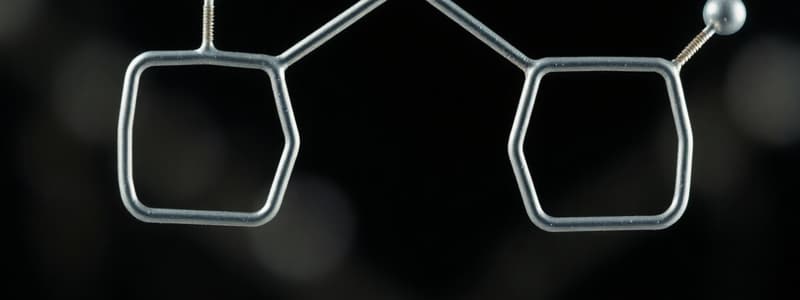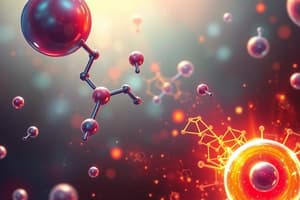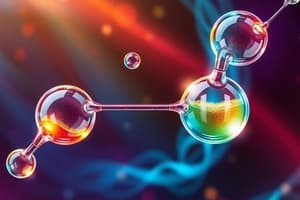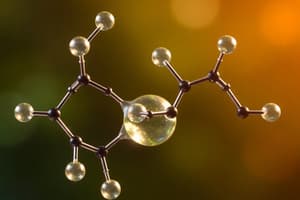Podcast
Questions and Answers
What is the primary reason acid chlorides are not used as pharmaceutical drugs?
What is the primary reason acid chlorides are not used as pharmaceutical drugs?
- They are too expensive to synthesize.
- They are difficult to store.
- They are too reactive. (correct)
- They do not undergo nucleophilic acyl substitution.
What product is formed when acid chlorides react with water?
What product is formed when acid chlorides react with water?
- Secondary amide
- Primary alcohol
- Ester
- Carboxylic acid (correct)
Which reagent is used to synthesize acid chlorides from carboxylic acids?
Which reagent is used to synthesize acid chlorides from carboxylic acids?
- Hydrochloric acid (HCl)
- Sodium chloride (NaCl)
- Thionyl chloride (SOCl2) (correct)
- Sulfuric acid (H2SO4)
What type of reaction occurs when acid chlorides react with alcohols?
What type of reaction occurs when acid chlorides react with alcohols?
In the context of acid chlorides, what occurs during the nucleophilic acyl substitution mechanism?
In the context of acid chlorides, what occurs during the nucleophilic acyl substitution mechanism?
Which reagent can be used to neutralize HCl in reactions involving amines?
Which reagent can be used to neutralize HCl in reactions involving amines?
Which of the following is a primary amine product from the reaction of acid chlorides?
Which of the following is a primary amine product from the reaction of acid chlorides?
What reaction mechanism is involved when acid chlorides react with amines?
What reaction mechanism is involved when acid chlorides react with amines?
Which compound is an example of an acid chloride that can react with amines?
Which compound is an example of an acid chloride that can react with amines?
Which product is formed from the reduction of 4-nitrobenzoic acid?
Which product is formed from the reduction of 4-nitrobenzoic acid?
The reaction of acid chlorides with NH3 leads to the formation of which type of functional groups?
The reaction of acid chlorides with NH3 leads to the formation of which type of functional groups?
What is the role of Raney Ni in chemical reactions involving carbonyl compounds?
What is the role of Raney Ni in chemical reactions involving carbonyl compounds?
What intermediate is formed when a nucleophile reacts with a carbonyl compound?
What intermediate is formed when a nucleophile reacts with a carbonyl compound?
Why are aldehydes more reactive than ketones in nucleophilic addition reactions?
Why are aldehydes more reactive than ketones in nucleophilic addition reactions?
What change occurs at the carbon atom of a carbonyl compound when it forms a chiral center?
What change occurs at the carbon atom of a carbonyl compound when it forms a chiral center?
Which of the following is a good nucleophile for reactions with carbonyl compounds?
Which of the following is a good nucleophile for reactions with carbonyl compounds?
What is the primary outcome of hydride addition to an aldehyde or ketone?
What is the primary outcome of hydride addition to an aldehyde or ketone?
What effect do alkyl groups have on the carbonyl carbon in aldehydes and ketones?
What effect do alkyl groups have on the carbonyl carbon in aldehydes and ketones?
What is the nature of the transition state during the nucleophilic addition in aldehydes?
What is the nature of the transition state during the nucleophilic addition in aldehydes?
Which process describes cyanohydrin formation from a carbonyl compound?
Which process describes cyanohydrin formation from a carbonyl compound?
What is the product of reducing an aldehyde using sodium borohydride (NaBH4)?
What is the product of reducing an aldehyde using sodium borohydride (NaBH4)?
How many moles of ketone can 1 mole of sodium borohydride reduce?
How many moles of ketone can 1 mole of sodium borohydride reduce?
Which compound is known as a donor of hydride ions?
Which compound is known as a donor of hydride ions?
What is the typical oxidation product of an aldehyde?
What is the typical oxidation product of an aldehyde?
During the oxidation of aldehydes, which functional group is involved in the reaction?
During the oxidation of aldehydes, which functional group is involved in the reaction?
What type of alcohol does lithium aluminum hydride (LiAlH4) yield from ketones?
What type of alcohol does lithium aluminum hydride (LiAlH4) yield from ketones?
Which chemical agent is a commonly used oxidizer of aldehydes?
Which chemical agent is a commonly used oxidizer of aldehydes?
Which of the following describes the term 'anomers'?
Which of the following describes the term 'anomers'?
After through cyclization, which form of D-Glucose constitutes the majority in solution?
After through cyclization, which form of D-Glucose constitutes the majority in solution?
Which statement about the oxidation of ketones is true?
Which statement about the oxidation of ketones is true?
What determines the reactivity of carboxylic acid derivatives?
What determines the reactivity of carboxylic acid derivatives?
Which of the following statements about nucleophilic acyl substitution is true?
Which of the following statements about nucleophilic acyl substitution is true?
What structural forms result from the placement of the -OH group at C-1 of D-Glucose?
What structural forms result from the placement of the -OH group at C-1 of D-Glucose?
Which carboxylic acid derivative is considered the least reactive?
Which carboxylic acid derivative is considered the least reactive?
What is the first step of acyl nucleophilic substitution?
What is the first step of acyl nucleophilic substitution?
What effect do weaker bases have on the carbonyl carbon?
What effect do weaker bases have on the carbonyl carbon?
Which of the following is a consequence of effective orbital overlap in carboxylic acid derivatives?
Which of the following is a consequence of effective orbital overlap in carboxylic acid derivatives?
Which of the following is NOT a method to activate carboxylic acids?
Which of the following is NOT a method to activate carboxylic acids?
Which characteristic makes acid halides the most reactive carboxylic acid derivatives?
Which characteristic makes acid halides the most reactive carboxylic acid derivatives?
In nucleophilic acyl substitution, which factor contributes to a tetrahedral intermediate's stability?
In nucleophilic acyl substitution, which factor contributes to a tetrahedral intermediate's stability?
Flashcards
Acid Chlorides and Drug Synthesis
Acid Chlorides and Drug Synthesis
Chloride is a good leaving group making the molecule very reactive. This reactivity makes it unsuitable to be used directly as a pharmaceutical drug, but it is useful for synthesizing many different drug molecules.
Hydrolysis of Acid Chlorides
Hydrolysis of Acid Chlorides
The reaction of acid chlorides with water results in the formation of carboxylic acids. This reaction is called hydrolysis.
Formation of Esters
Formation of Esters
When acid chlorides react with alcohols in the presence of a base, esters are formed.
Formation of Secondary Amides
Formation of Secondary Amides
Signup and view all the flashcards
Synthesis of Acid Chlorides: Thionyl Chloride
Synthesis of Acid Chlorides: Thionyl Chloride
Signup and view all the flashcards
Amide Synthesis
Amide Synthesis
Signup and view all the flashcards
Base in Amide Synthesis
Base in Amide Synthesis
Signup and view all the flashcards
Conversion of Carboxylic Acid to Acid Chloride
Conversion of Carboxylic Acid to Acid Chloride
Signup and view all the flashcards
Nitro Group Reduction
Nitro Group Reduction
Signup and view all the flashcards
Raney Nickel
Raney Nickel
Signup and view all the flashcards
General Reaction Mechanism
General Reaction Mechanism
Signup and view all the flashcards
Lidocaine
Lidocaine
Signup and view all the flashcards
Chloroacetyl Chloride
Chloroacetyl Chloride
Signup and view all the flashcards
Nucleophilic Addition to Carbonyl Compounds
Nucleophilic Addition to Carbonyl Compounds
Signup and view all the flashcards
Tetrahedral Intermediate Formation
Tetrahedral Intermediate Formation
Signup and view all the flashcards
Reactivity of Aldehydes vs Ketones
Reactivity of Aldehydes vs Ketones
Signup and view all the flashcards
Cyanohydrin Formation
Cyanohydrin Formation
Signup and view all the flashcards
Reduction of Aldehydes and Ketones
Reduction of Aldehydes and Ketones
Signup and view all the flashcards
Alkyl Groups Effect on Electrophilicity
Alkyl Groups Effect on Electrophilicity
Signup and view all the flashcards
Chirality in Carbonyl Addition
Chirality in Carbonyl Addition
Signup and view all the flashcards
Good Nucleophiles for Carbonyl Addition
Good Nucleophiles for Carbonyl Addition
Signup and view all the flashcards
Hydride Reduction
Hydride Reduction
Signup and view all the flashcards
Sodium Borohydride (NaBH4)
Sodium Borohydride (NaBH4)
Signup and view all the flashcards
Lithium Aluminum Hydride (LiAlH4)
Lithium Aluminum Hydride (LiAlH4)
Signup and view all the flashcards
Primary Alcohol
Primary Alcohol
Signup and view all the flashcards
Secondary Alcohol
Secondary Alcohol
Signup and view all the flashcards
Oxidation of Aldehydes
Oxidation of Aldehydes
Signup and view all the flashcards
Alcoholysis
Alcoholysis
Signup and view all the flashcards
Cyclization of D-Glucose
Cyclization of D-Glucose
Signup and view all the flashcards
Anomers (Alpha and Beta)
Anomers (Alpha and Beta)
Signup and view all the flashcards
NADH (Nicotinamide Adenine Dinucleotide)
NADH (Nicotinamide Adenine Dinucleotide)
Signup and view all the flashcards
Axial vs. Equatorial -OH in Glucose
Axial vs. Equatorial -OH in Glucose
Signup and view all the flashcards
What ring sizes are possible for glucose?
What ring sizes are possible for glucose?
Signup and view all the flashcards
Nucleophilic Acyl Substitution
Nucleophilic Acyl Substitution
Signup and view all the flashcards
Reactivity of Carboxylic Acid Derivatives
Reactivity of Carboxylic Acid Derivatives
Signup and view all the flashcards
Inductive Effects in Carboxylic Acid Derivatives
Inductive Effects in Carboxylic Acid Derivatives
Signup and view all the flashcards
Orbital Overlap in Carboxylic Acid Derivatives
Orbital Overlap in Carboxylic Acid Derivatives
Signup and view all the flashcards
Activation of Carboxylic Acids
Activation of Carboxylic Acids
Signup and view all the flashcards
Tetrahedral Intermediate in Acyl Substitution
Tetrahedral Intermediate in Acyl Substitution
Signup and view all the flashcards
Factors Affecting Reactivity of Carboxylic Acid Derivatives
Factors Affecting Reactivity of Carboxylic Acid Derivatives
Signup and view all the flashcards
Why are amides the least reactive?
Why are amides the least reactive?
Signup and view all the flashcards
Study Notes
MPharm Programme - PHA114 Carbonyl Compounds 2
- Carbonyl compounds – electron pair moves from C=O bond to electronegative oxygen atom creating tetrahedral alkoxide ion intermediate
- Formation of new bonds increases steric crowding
- Introduction of chiral center (carbonyl carbon sp2 -> tetrahedral carbon sp3)
- Good nucleophiles: hydride, alkynyl anions, alkoxides
- Nucleophile may approach from above or below plane of C=O leading to chiral center if all four atoms on the C atom are different
Relative Reactivity of Aldehydes and Ketones
- Aldehydes are generally more reactive than ketones in nucleophilic addition reactions
- The transition state for addition is less crowded and lower in energy for an aldehyde
- Aldehydes: one large substituent bonded to the C=O
- Ketones: two large substituent bonded to the C=O
- Alkyl groups are electron releasing
- Aldehyde has greater partial positive charge on carbonyl carbon than ketone
- Aldehyde carbon is more electrophilic than ketone carbon
Cyanohydrin Formation
- Cyanohydrin formation involves the addition of cyanide, then elimination of cyanide, followed by cyanohydrin formation
- The process includes hydrolysis and reduction
Reduction of Aldehydes and Ketones
- Hydride addition converts R-C=O to R-C-OH
- Donors of hydride ion (H−) = sodium borohydride (NaBH4) or lithium aluminum hydride (LiAlH4)
- Protonation yields the alcohol (from solvent or acid)
- Aldehyde reduced to primary alcohol
- Ketone reduced to secondary alcohol
- Stereochemistry
Biological Reduction - Hydride Transfer
- NADH and NAD+ are involved in biological reduction processes as reducing and oxidizing agents respectively
- NADH is a reducing agent.
- NAD+ is an oxidizing agent
- Addition from either face of planar group
- Stereospecific reduction; hydride attacks from front face (Re)
Oxidation of Aldehydes
- Aldehydes are easily oxidized to carboxylic acids
- Loss of –CHO hydrogen during oxidation.
- Can be oxidized chemically (CrO3, KMnO4, HNO3)
- Ketones are relatively inert towards oxidation
Aldehydes/Ketones Alcoholysis
- Protonation of carbonyl oxygen strongly polarizes carbonyl group
- Activates the carbonyl group for nucleophilic attack
- Loss of a proton yields neutral hemiacetal tetrahedral intermediate
- Protonation of hemiacetal hydroxyl converts it into a good leaving group
- Dehydration yields intermediate oxonium ion
- Addition of second alcohol equivalent gives protonated acetal
- Loss of proton yields neutral acetal product
Biological Relevance: Cyclization of D-Glucose
- Intramolecular reaction results in cyclisation
- Anomers: two sugars that differ in configuration at anomeric carbon
- The -OH group at C-1 can be axial or equatorial, resulting in two structural forms
- α-anomer, 36%
- open-chain, <0.05%
- β-anomer, 64%
Cyclisation of D-Glucose
- Wavy bond indicates either stereochemistry
- Pyranose form
- Hemiacetal
- Fischer projection
- Equilibria of sugars; display carbonyl reactions
Nucleophilic Acyl Substitution
- Reaction occurs when: Y is –Br, –Cl, –OR, –NR2
- Reaction does NOT occur when: Y = –H, –R
- All carboxylic acid derivatives react by the same general mechanism
- Polarity of the carbonyl group
- Carboxylic acid derivatives have an acyl carbon bonded to a group that can leave
- Nucleophile adds to the carbonyl carbon to form a tetrahedral anionic intermediate
- Leaving group is expelled to generate a new carbonyl compound, resulting in substitution
- Overall an addition-elimination sequence
- Tetrahedral intermediate eliminates the weakest base
- Some carboxylic acid derivatives require acid catalysis to promote reaction
Reactivity
- Reactivity decreases as the leaving group becomes more basic
- Acid chlorides, anhydrides, esters, amides, carboxylates are listed in decreasing reactivity order
Inductive Effects
- A weaker base is a more electronegative base
- Better able to accommodate its own negative charge
- Weaker bases are better at inductive electron withdrawal from carbonyl carbon
- Increases electrophilicity of a carbonyl carbon
- More electrophilic carbonyl groups are more reactive to addition
- Acid halides are most reactive, amides least reactive
- Carbonyl carbon is more susceptible to nucleophilic attack
- First step of acyl nucleophilic substitution is easier
Orbital Overlap in Carboxylic Acid Derivatives
- Resonance
- The more effective the overlap, the more stable the derivative, the less reactive the derivative
Activation of Carboxylic Acids
- Convert OH group to a better leaving group
- Acid halide or acid anhydride
- Activated forms of the carboxylic acid
- Analogous to biological processes
- Chloride is a good leaving group; undergoes acyl substitution easily
- Not useful as pharmaceutical drugs; too reactive
- Useful in synthesis of drug molecules to form esters and amides
- To synthesise acid chlorides: react carboxylic acid with thionyl chloride (SOCl2).
Acid Chlorides - Reactions
- Nucleophilic acyl substitution
- Halogen replaced by nucleophile
- Hydrolysis yields a carboxylic acid
- Reduction yields a primary alcohol
Acid Chlorides - Reactions (Hydrolysis)
- Acid chlorides react with water to yield carboxylic acids (hydrolysis reaction)
- Water attacks the acid chloride –carbonyl group.
Acid Chlorides – Reactions (-> Esters/Amides)
- Esters are produced from the reaction of acid chlorides with alcohols
- Amides result from the reaction of acid chlorides with NH3
Studying That Suits You
Use AI to generate personalized quizzes and flashcards to suit your learning preferences.




